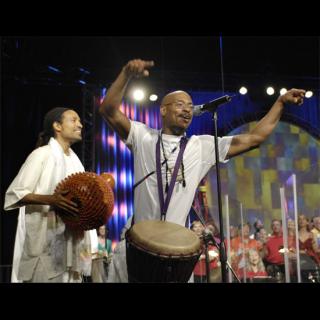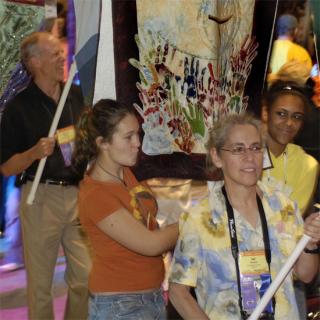Opening Celebration
General Assembly 2008 Event 1030 (Celebration)
To watch this event, see our Video Coverage.
“Willkommen, bienvenue, welcome!” sang David Fisher, the Florida District Coordinator for the 2008 General Assembly (GA) of Congregations. “Willkommen, bienvenue, welcome, Im GA, au GA, to GA,” he continued, in a parody of the opening song of the musical Cabaret. There was delighted laughter from the more than three thousand Unitarian Universalists gathered in main hall of the Fort Lauderdale Convention Center for the opening celebration of General Assembly. Fisher told those gathered that the theme for this year’s General Assembly is “Common Threads.”
The Rev. Marni Harmony, interim minister at Emerson Unitarian Universalist Congregation in Marietta, Georgia, spoke as the flaming chalice was lit, saying: “As we light our chalice this night may we see the light as a sunburst, as a god-star, shooting out of darkness… sparking within us a sacred hunger for connection.”
The Rev. William Sinkford, president of the Unitarian Universalist Association, greeted the gathered congregation. “Well, my friends we’ve done it,” he said to cheers and applause. “Again the congregations have gathered in one strong body, the larger family faith is manifest once more.” He continued, “Let the banner parade begin!”
With those words, representatives from many different Unitarian Universalist congregations paraded down the central aisle of the hall carrying colorful banners with designs symbolizing their congregations. Images included everything from swirling abstract designs to an image of a classic New England church building. The banners were from congregations as far away as the Unitarian Universalist Church of the Philippines, and as close as the Unitarian Universalist Church of Fort Lauderdale. One banner, from the Spanish-language congregation at the First Unitarian Church in San Jose, was completely in Spanish. The people accompanying the banners ranged in age from babes in arms to elders.
The banner parade was followed by the first session of the Plenary business meeting (see separate story). When the plenary session concluded, the opening celebration continued with a performance of Sources: A Unitarian Universalist Cantata, with music by the Rev. Jason Shelton, associate minister for music at First Unitarian Universalist Church of Nashville, Tennessee, and words by the Rev. Dr. Kendyl Gibbons, senior minister at First Unitarian Society in Minneapolis, Minneapolis, and additional words by Justice Whittaker.
The Sources cantata, first performed in June 2006, has seven movements. The first six movements correspond to the six Sources of Unitarian Universalist religious inspiration, as set forth in the bylaws of the Unitarian Universalist Association (section C-2.1). The seventh and final movement, titled “The Promise,” refers to the principle of covenant which binds the diversity of Unitarian Universalism together. For an in-depth article about the meaning and purpose of this cantata, see the article “The Sources Sing” in the summer, 2008, issue of UU World magazine.
Conducted by Dr. Jo-Michael Scheibe, this eagerly awaited performance of the Sources cantata was a major production, involving a sixteen-piece string section, the percussion ensemble Heritage O. P., drummer, pianist, a narrator, a storyteller, and a 68-voice auditioned choir. The choir included many prominent Unitarian Universalist music directors and composers. Dr. Scheibe is chair and professor in the department of choral and sacred music at the University of Southern California.
The first movement, titled “In the Beginning,” was firmly in the tradition of recent Western classical music, blending complicated rhythms played by the percussionists, and unusual harmonies from the choir and strings. Abstract images appeared on a circular screen behind the choir, and continued to appear throughout the performance. The acoustics of the hall tended to obscure the excellent performance by the choir and orchestra during this movement.
Applause greeted the end of the first movement. The narrator, the Rev. Marta Valentin, interim minister at First Church Unitarian in Littleton, Massachusetts, stepped forward and read the Source from which the first movement was drawn. Valentin appeared at the end of each movement to read the corresponding source for that movement, often in both Spanish and English.
The second movement of this post-modern cantata, titled “Transformation,” employed a different musical genre from the first movement, switching from Western classical music to Latin jazz. Each succeeding movement of the cantata employed a new musical genre. In the second movement, mezzo-soprano Jeannie Gagné stepped forward to sing a short solo, then sang lead over the choir.
The third movement, titled “All Lifted Hearts,” included a short lyrical theme that the congregation was invited to join in singing. Composer Jason Shelton had appeared before the beginning of the opening celebration to teach this theme to the congregation. During the third movement, tenor Ian Riddell came forward as soloist and led the congregation in singing this Taizé-like meditational chant. Shelton and Gibbons provided narration that pointed out that different religious traditions frequently offer similar religious insights. At the end of the movement, the choir softly chanted words from different languages, all with the meaning “peace”: “Shanti, shalom, hasiti, salaam….” A hush came over the congregation at the conclusion of the movement.
The fourth movement, “On Wings of Praise,” began with a brief musical theme that resembled traditional European Jewish music. But the music quickly moved to a rocking gospel sound, with heavy drums, and the choir swaying in time with the music. Soloist Tony Jackson gave a knock-out performance, singing gospel with R&B influence. The movement celebrated the Jewish and Christian religious traditions. Loud applause greeted the end of the movement.
During the fifth movement, titled “No Other World,” soprano soloist Allison Wilski sang, “I would seek wisdom in human reality even if wisdom be pain; sing me no pious amens.” This lyrical movement echoed Broadway musicals. After Wilski sang with just piano accompaniment, the choir and strings joined in. Once again, the congregation applauded at the end of this movement.
For the sixth movement, “The Sacred Circle,” storyteller Emily Green-Cain took center stage. “Once I dreamt I beheld a great council of all creation,” she began. Mysterious-sounding percussion accompanied her quietly dramatic words and graceful hand gestures. The strings and choir joined in, and the movement built to a quiet climax. At the beginning of the opening celebration, Green-Cain had taught the congregation simple hand gestures for this movement, and many in the congregation followed her in using those hand gestures at the appropriate moment. The movement ended quietly.
Narrator Valentin gave a short introduction to the seventh and final movement. After asking what holds these diverse sources of religious inspiration together, she replied, “It is in our covenant that we find an answer.”
Hip hop artist Justice Whittaker, leader of the leader of the Five.12 Collective whirled on stage to a strong beat carried by electric bass and drum kit. Whittaker, wearing a wrist band in the colors of the African American national flag, got the congregation to say “Amen,” and then dove into spoken word improvisation. “The spirit is in me and the spirit is in you,” he said, “Now put your finger in the air, now let’s make that finger a fist…. Let your energy lead you to liberation.” Over music provided by the rhythm section, the choir, and soloist Gagné, Whittaker went into a high-energy rap, or spoken word poem.
The performance of the seventh movement of the cantata represents the very first time hip hop music was heard at General Assembly. People in the congregation were moving in their seats, and the entire youth caucus was standing and moving to the beat. Whittaker ended by pumping his fist in the air as a symbol of liberation. A middle-aged person was overheard saying, “That was great!”
Following the conclusion of the cantata, Rev. Kendyl Gibbons gave a peaceful and pastoral benediction to close the opening celebration.
After the benediction, the congregation burst into applause. Conductor Scheibe invited applause for the various musicians and soloists. Shelton and Gibbons took the final bow, and were greeted by cheers and applause.
Additional information on Sources, including availability on loan to Unitarian Universalist congregations or groups of congregations of printed scores and parts, is available at Jason Shelton’s website.
Reported by Dan Harper; edited by Jone Johnson Lewis.


